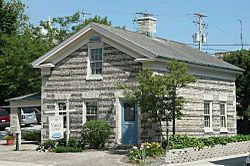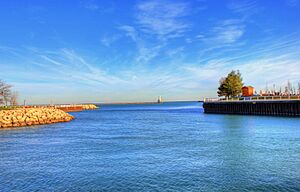Port Washington, Wisconsin facts for kids
Quick facts for kids
Port Washington, Wisconsin
|
||
|---|---|---|
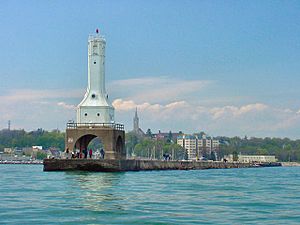
Port Washington Pierhead Light, as viewed from Lake Michigan
|
||
|
||
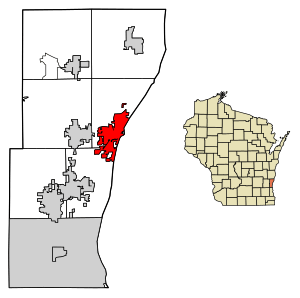
Location of Port Washington in Ozaukee County, Wisconsin.
|
||
| Country | ||
| State | ||
| County | Ozaukee | |
| Settled | 1835 | |
| Incorporated | 1882 | |
| Government | ||
| • Type | Mayor-council | |
| Area | ||
| • Total | 5.86 sq mi (15.19 km2) | |
| • Land | 5.86 sq mi (15.19 km2) | |
| • Water | 0.00 sq mi (0.00 km2) | |
| Population
(2020)
|
||
| • Total | 12,353 | |
| • Density | 2,031.21/sq mi (784.29/km2) | |
| Time zone | UTC-6 (Central (CST)) | |
| • Summer (DST) | UTC-5 (CDT) | |
| ZIP Code |
53074
|
|
| Area code(s) | 262 | |
| FIPS code | 55-64450 | |
Port Washington is a city in Wisconsin, United States. It is the main city of Ozaukee County. The city is located on the western shore of Lake Michigan. It is about 27 miles north of Milwaukee.
Port Washington has a special harbor. This harbor was built in the 1870s. It was used for shipping goods until the early 2000s. In 2020, about 12,353 people lived here.
When French explorers arrived in the 1600s, they found a Native American village here. Later, in the 1830s, the first American settlers came. They first called the area "Wisconsin City." Then they changed the name to "Port Washington" to honor President George Washington.
For a long time, Port Washington's history has been linked to the Great Lakes. Early settlers used boats to move goods like wood and fish. The city built a harbor in 1871 to help ships and prevent shipwrecks. Fishing was a big business until the mid-1900s. A power plant also used the harbor to get coal. Today, the harbor is used for fun boating. The city celebrates its lake history with museums and fishing events.
Contents
History of Port Washington
Early Days and First Settlers
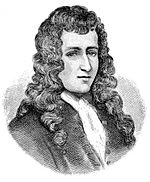
The land where Port Washington is now was first home to Native American tribes. These included the Menominee, Potawatomi, and Sauk people. In 1679, French explorers like René-Robert Cavelier, Sieur de La Salle visited the area. They described a Potawatomi village near a small river, which might have been Sauk Creek.
In the 1830s, Native Americans were forced to leave Wisconsin. Then, people started buying land to build new towns. General Wooster Harrison bought the land for Port Washington in 1835. He first called it "Wisconsin City." The settlement was empty for a few years after 1837.
In 1843, Harrison came back with more settlers. The Town of Port Washington was officially formed in 1846. At first, it included nearby areas like Fredonia and Belgium.
Port Washington was part of Washington County then. It was considered to be the main city, or "county seat." But it was far from other early towns in the county. In 1853, the state decided to split Washington County into two parts. This created Ozaukee County, and Port Washington became the main city for this new county.
Growth and Industry in the 1800s
Early settlers wanted to make Port Washington a busy port on Lake Michigan. They built piers to load and unload goods. The city sent out wood, flour, bricks, and fish. But Port Washington didn't have a natural harbor. Many ships were wrecked, like the Toledo in 1856, where many people died.
In the 1840s, the first church services were held in homes. The town's first newspaper started in 1847. The population grew to 2,500 by 1853. Many immigrants from Germany and Luxembourg moved to Port Washington.
During the American Civil War, some immigrants were not happy about the draft. The draft meant men had to join the army. On November 10, 1862, some residents protested. They marched to the courthouse, destroyed draft papers, and damaged homes. Union soldiers from Milwaukee had to come to stop the riot.
Better transportation came in the 1870s. In 1870, a railroad line reached Port Washington. Also, the government built an artificial harbor in 1871. This harbor was 14 feet deep and 1500 feet long. It allowed ships to dock safely and shelter from storms.
The City of Port Washington officially became a city in 1882. More immigrants from France and Belgium arrived in the late 1800s.
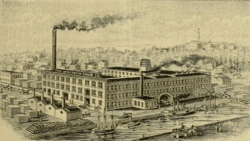
Port Washington's economy became more industrial. In 1888, the Wisconsin Chair Company opened. This company made chairs and other furniture. It became the biggest employer in the county. It created about half of all jobs in Port Washington. The city's population almost doubled because of the company's success.
Other companies also started. The Bolens tractor company built a factory in 1894. In 1896, the Smith Bros. started a commercial fishing business. They sold fish and other products. They even had restaurants and a hotel.
In 1899, the Wisconsin Chair Company factory caught fire. The fire spread and burned almost half of Port Washington. But the company rebuilt an even bigger factory by the water.
20th Century Changes
In the early 1900s, the Wisconsin Chair Company grew even more. They made phonographs for Thomas Edison. They also started Paramount Records, one of the first record labels for African-American music. The Wisconsin Chair Company closed in 1954.
In 1907, an interurban train line came to Port Washington. This train carried passengers between Milwaukee and Sheboygan. A power station on the lakefront provided electricity for the trains. The train line closed in 1948 because more people started using cars.
The Port Washington power plant was built in 1931. This project made the harbor bigger. It also built a large dock for coal shipments.
Commercial fishing on the Great Lakes declined in the mid-1900s. This was due to too much fishing, pollution, and new species that harmed the fish. The Smith Bros. fishing company closed in 1988. The power station stopped using coal in 2004. This meant the harbor was no longer used for commercial shipping.
After World War II, Port Washington grew a lot. Many people moved from cities to the suburbs. The population more than doubled between 1940 and 1970. New homes were built on land that used to be farms. Interstate 43 was built in the 1960s. This made it easier for people to travel for work.
On August 22, 1964, a strong tornado hit Port Washington. It destroyed 20 houses and damaged many more. No one died, but 30 people were hurt.
Geography and Nature
Port Washington covers about 7 square miles. About 5.8 square miles are land, and 1.2 square miles are water. The city is next to the Town of Port Washington and the Town of Grafton. Lake Michigan is to the east.
The city is on the western shore of Lake Michigan. In some parts, the coast has tall clay bluffs. These bluffs are 80 to 130 feet high. They are a special type of landform found in few other places. The beaches often have gravel and sand.
Downtown Port Washington is in a valley near Sauk Creek. This valley is lower than the rest of the city. It gave early settlers easy access to the lake. The artificial harbor is also at the mouth of Sauk Creek.
The area was shaped by glaciers during the last ice age. The soil is mostly clay.
Wildlife and Plants
As more land is developed, wild animals sometimes come closer to human areas. You might see white-tailed deer, coyotes, and red foxes in the city. Sometimes, black bears have been seen in Ozaukee County.
The region also has problems with invasive species. These are plants and animals that are not native to the area and can harm the local environment. Examples include the emerald ash borer (an insect that kills ash trees) and plants like common reed and purple loosestrife.
Climate
| Climate data for Port Washington, Wisconsin (1991–2020 normals, extremes 1893–present) | |||||||||||||
|---|---|---|---|---|---|---|---|---|---|---|---|---|---|
| Month | Jan | Feb | Mar | Apr | May | Jun | Jul | Aug | Sep | Oct | Nov | Dec | Year |
| Record high °F (°C) | 59 (15) |
63 (17) |
82 (28) |
92 (33) |
95 (35) |
102 (39) |
106 (41) |
103 (39) |
100 (38) |
89 (32) |
76 (24) |
68 (20) |
106 (41) |
| Mean daily maximum °F (°C) | 30.8 (−0.7) |
33.5 (0.8) |
41.9 (5.5) |
51.0 (10.6) |
61.3 (16.3) |
71.5 (21.9) |
78.7 (25.9) |
78.4 (25.8) |
71.3 (21.8) |
59.2 (15.1) |
46.4 (8.0) |
35.8 (2.1) |
55.0 (12.8) |
| Daily mean °F (°C) | 22.7 (−5.2) |
24.6 (−4.1) |
33.7 (0.9) |
43.2 (6.2) |
53.0 (11.7) |
63.2 (17.3) |
70.1 (21.2) |
70.0 (21.1) |
62.5 (16.9) |
50.4 (10.2) |
38.5 (3.6) |
28.2 (−2.1) |
46.7 (8.2) |
| Mean daily minimum °F (°C) | 14.6 (−9.7) |
15.7 (−9.1) |
25.4 (−3.7) |
35.4 (1.9) |
44.8 (7.1) |
54.8 (12.7) |
61.5 (16.4) |
61.6 (16.4) |
53.7 (12.1) |
41.6 (5.3) |
30.6 (−0.8) |
20.5 (−6.4) |
38.4 (3.6) |
| Record low °F (°C) | −26 (−32) |
−29 (−34) |
−15 (−26) |
10 (−12) |
18 (−8) |
29 (−2) |
40 (4) |
36 (2) |
27 (−3) |
11 (−12) |
−10 (−23) |
−22 (−30) |
−29 (−34) |
| Average precipitation inches (mm) | 1.76 (45) |
1.48 (38) |
1.91 (49) |
3.78 (96) |
3.90 (99) |
4.17 (106) |
3.61 (92) |
3.68 (93) |
3.08 (78) |
2.56 (65) |
2.13 (54) |
1.82 (46) |
33.88 (861) |
| Average snowfall inches (cm) | 13.2 (34) |
10.7 (27) |
6.0 (15) |
0.8 (2.0) |
0.0 (0.0) |
0.0 (0.0) |
0.0 (0.0) |
0.0 (0.0) |
0.0 (0.0) |
0.0 (0.0) |
0.9 (2.3) |
10.7 (27) |
42.3 (107) |
| Average precipitation days (≥ 0.01 in) | 8.1 | 6.7 | 7.7 | 9.9 | 11.1 | 10.4 | 8.7 | 8.1 | 7.8 | 9.1 | 7.6 | 7.8 | 103.0 |
| Average snowy days (≥ 0.1 in) | 6.4 | 5.1 | 2.7 | 0.5 | 0.0 | 0.0 | 0.0 | 0.0 | 0.0 | 0.0 | 0.9 | 4.6 | 20.2 |
| Source: NOAA | |||||||||||||
People of Port Washington
| Historical population | |||
|---|---|---|---|
| Census | Pop. | %± | |
| 1880 | 1,386 | — | |
| 1890 | 1,649 | 19.0% | |
| 1900 | 3,010 | 82.5% | |
| 1910 | 3,792 | 26.0% | |
| 1920 | 3,340 | −11.9% | |
| 1930 | 3,693 | 10.6% | |
| 1940 | 4,046 | 9.6% | |
| 1950 | 4,755 | 17.5% | |
| 1960 | 5,984 | 25.8% | |
| 1970 | 8,752 | 46.3% | |
| 1980 | 8,612 | −1.6% | |
| 1990 | 9,338 | 8.4% | |
| 2000 | 10,467 | 12.1% | |
| 2010 | 11,250 | 7.5% | |
| 2020 | 12,353 | 9.8% | |
| U.S. Decennial Census | |||
Population in 2010
In 2010, there were 11,250 people living in Port Washington. There were 4,704 households. The average number of people per household was 2.31.
The average age in the city was 39.5 years old. About 22.4% of residents were under 18. About 14.7% were 65 or older. The population was almost evenly split between males (49.0%) and females (51.0%).
Economy and Jobs
In the early days, Port Washington's economy was based on natural resources. People harvested and shipped wood, fish, and grains. Later, dairy farming became important in the surrounding area. By the mid-1900s, dairy farming made up 80% of the agriculture.
In the late 1800s, Port Washington became more industrial. The Wisconsin Chair Company was the biggest employer. In the 1900s, other companies like Allen Edmonds and Bolens Corporation also had factories here. Today, Allen Edmonds still makes high-quality shoes in the city. Many other factories closed or were bought by bigger companies. In 2015, about 25% of jobs in Port Washington were in manufacturing.
Today, government jobs are a big part of Port Washington's economy. The Ozaukee County government is the largest employer. The city government also employs many people.
| Largest Employers in Port Washington, 2015 | |||
|---|---|---|---|
| Rank | Employer | Industry | Employees |
| 1 | Ozaukee County | Public administration | 500–999 |
| 2 | Kleen Test Products | Cleaning product manufacturing | 250–499 |
| 3 | Allen Edmonds | Footwear and high-end apparel manufacturing | 250–499 |
| 4 | Kickhaefer Manufacturing Company | OEM metal fabrication and stamping | 250–499 |
| 5 | Port Washington-Saukville School District | Primary and secondary education | 100–249 |
| 6 | City of Port Washington | Public Administration | 100–249 |
| 7 | Franklin Energy Services | Energy efficiency consultant | 100–249 |
| 8 | Construction Forms Inc. | Pipe and pipe fitting manufacturing | 50–99 |
| 9 | Aurora Health Care | Health care | 50–99 |
| 10 | Heritage Nursing & Rehabilitation | Nursing care facility | 50–99 |
Culture and Fun
Events and Celebrations
Port Washington has many yearly events that celebrate its connection to the lake.
- On January 1st, over 100 people jump into Lake Michigan for the "polar bear plunge."
- Fish Day is held every July. It's called the "world's largest one-day outdoor fish fry." It's a charity event that has been happening since 1964.
- In the summer, there's a Festival of the Arts. There are also sailboat races and sport fishing contests.
- The city also celebrates holidays like Independence Day, Labor Day, Halloween, and Christmas.
Museums to Explore
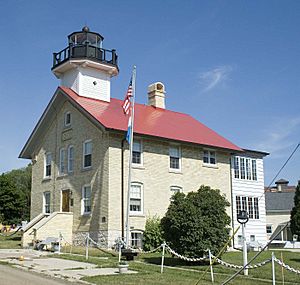
- Judge Eghart House: This house was built in 1872. It's now a museum filled with items from the 1800s. It shows what life was like back then.
- Port Washington Light: This lighthouse was built in 1860. It's on the National Register of Historic Places. The country of Luxembourg helped restore it in 2000. This was because of the cultural ties between the area and Luxembourg. It's a museum about lighthouse keeping. You can take tours on summer weekends.
Places of Worship
Port Washington has several churches. There are three Lutheran churches: Christ the King, St. John's, and St. Matthew Evangelical Lutheran Church. Other churches include First Congregational Church, Grand Avenue United Methodist Church, and St. Simon the Fisherman Episcopal Church. Faith Baptist Church is also in the community.
St. John XXIII Catholic Parish was formed in 2016. It combined Port Washington's two historic Catholic churches with a church in Saukville. The three church buildings are still used. The parish also runs a school for kids from kindergarten to eighth grade.
There are also two evangelical churches: Friedens Church and Portview Church. Open Door Bible Church is a Christian fundamentalist church.
Port Washington also has a Church of Jesus Christ of Latter-day Saints and a Jehovah's Witnesses Kingdom Hall.
W. J. Niederkorn Library
The city's first public library started in 1899. It got its own building in 1961. This was thanks to W. J. Niederkorn, who paid for it. The library offers books, magazines, computers, and study rooms. It also has audiobooks, e-books, and language-learning software. It is part of the Monarch Library System. This system includes 31 libraries in four counties.
Education in Port Washington
Port Washington is part of the Port Washington-Saukville School District. The district has three elementary schools for kindergarten through fourth grade. Lincoln Elementary serves students in northern and eastern Port Washington. Dunwiddie Elementary serves students in southern and western neighborhoods. Saukville Elementary serves students in nearby areas.
All students in the district go to Thomas Jefferson Middle School for fifth through eighth grades. They then attend Port Washington High School for ninth through twelfth grades.
A nine-member elected school board governs the district. They meet on Mondays at 6 p.m. The district also has a full-time superintendent.
St. John XXIII Catholic Parish also runs a parochial school in the city. It serves students from kindergarten through eighth grade.
Getting Around Port Washington
Interstate 43 runs west and north of Port Washington. You can get to it from Exit 100. Wisconsin Highway 32 goes north to south through the city. Wisconsin Highway 33 comes from the west and ends downtown.
Port Washington Harbor was built in the early 1870s. It was a commercial port. The government has to dredge the harbor every few decades. This keeps the channels deep enough for boats. The power plant used to get coal shipments through the harbor. But in 2004, it switched to natural gas. So, the commercial port closed. Now, the harbor is a marina for people who boat for fun. It's open from April to November.
Port Washington has some public transportation. The Route 143 commuter bus, called the "Ozaukee County Express," goes to Milwaukee. The closest stop is at the Saukville Walmart parking lot. This bus runs Monday to Friday during busy commute times.
Ozaukee County Transit Services also offers a Shared Ride Taxi. This is a public transit option for places not on the main bus route. The taxis run seven days a week. You need to call ahead to schedule your pick-up. The service plans routes based on where people need to go.
Most areas of Port Washington have sidewalks for walking. The Ozaukee Interurban Trail also runs through the city. This trail is for walking and biking. It connects Port Washington to Grafton in the south and Belgium in the north. The trail used to be a train line. It ran from Milwaukee to Sheboygan from 1907 to 1948. In the 1990s, the old rail line became this recreational trail.
The city does not have passenger train service. But the Union Pacific Railroad operates freight trains here.
Parks and Outdoor Fun
Port Washington has 29 public parks. They have picnic areas, baseball fields, tennis courts, and nature spots. There is also a public pool. The parks department offers recreation programs. They also organize sports leagues for adults.
The Port Washington marina is open for recreational boaters from April to November. People can fish for lake trout and Chinook salmon from the breakwaters. The Port Washington Yacht Club hosts sailboat races in June and August. The Great Lakes Sport Fishermen host a fishing derby in July. The local Lions Club also hosts a fishing contest.
The Ozaukee Interurban Trail goes through Port Washington. It follows an old train route. The trail connects Port Washington to nearby towns like Grafton and Belgium.
The Wisconsin Shipwreck Coast National Marine Sanctuary was created in 2021. It is in Lake Michigan off Port Washington. This area has many important shipwrecks.
Famous People from Port Washington
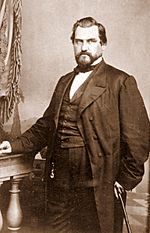
- A. Manette Ansay, writer
- Vernon Biever, photographer
- Dustin Diamond, actor
- Alex Dieringer, wrestler
- Josh Gasser, professional basketball player
- Janine P. Geske, judge
- Leland Stanford, U.S. Senator, Governor of California, and founder of Stanford University
- Rich Strenger, National Football League player
Sister City
Port Washington's sister city is Sassnitz, Germany. They became sister cities in 2017.
Images for kids
See also
 In Spanish: Port Washington (Wisconsin) para niños
In Spanish: Port Washington (Wisconsin) para niños





